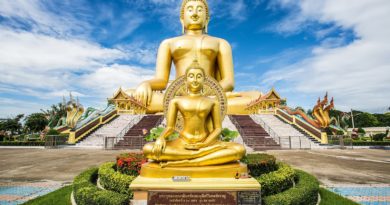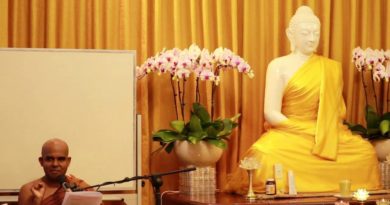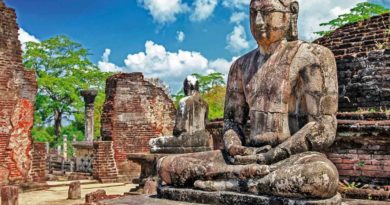Abhidhamma In Daily Life – Bhante Cakkapala (eng)
Bhante Cakkapala – Abhidhamma In Daily Life
Mangala Vihara Buddhist Temple, 30 Jln Eunos, Singapore 419495
He was ordained as a sāmaṇera (novice monk) at the age of 12 and received higher ordination when he was 20. He Studied Buddhism in Mandalay for eleven years and was awarded the Dhammācariya ( Dhamma teacher) degree at the age of 22.
He taught religious classes to young novices and monks for three years. He went to Sri Lanka to pursue academic studies in Buddhism and graduated with Master Degree (Buddhist studies) from Kelaniya University in 2008.
He was one of the founding members of Dhamma School Foundation established in 2012. It is now the biggest religious association in Myanmar. It designs syllabuses for Buddhist youths and operates Sunday Dhamma Schools throughout the country.
He received an invitation from Mangala Vihara (Buddhist Temple) in Singapore to propagate the Dhamma in 2012 and has been residing there since. He is presently an assistant resident monk and has been teaching Buddhism to both local students and Burmese devotees.
Dhamma Talk Video
Abhidhamma in Daily Life
Part – 1 (Citta)
- Consciousness (Citta) –1
- Consciousness (Citta) –2
- Consciousness (Citta) –3
- Consciousness (Citta) –4
- Consciousness (Citta) –5
- Consciousness (Citta) –6
- Consciousness (Citta) –7
- Consciousness (Citta) –8
- Consciousness (Citta) –9
- Consciousness (Citta) –10
- Consciousness (Citta) –11
- Consciousness (Citta) –12
- Consciousness (Citta) –13
- Consciousness (Citta) –14
- Consciousness (Citta) –15
- Consciousness (Citta) –16
- Consciousness (Citta) –17
- Consciousness (Citta) –18
- Consciousness (Citta) –19
- Consciousness (Citta) –20
- Consciousness (Citta) –21
Part 2 (Cetasika)
- Mentor Factor (Cetasika) –1
- Mentor Factor (Cetasika) –2
- Mentor Factor (Cetasika) –3
- Mentor Factor (Cetasika) –4
- Mentor Factor (Cetasika) –5
- Mentor Factor (Cetasika) –6
- Mentor Factor (Cetasika) –7
- Mentor Factor (Cetasika) –8
- Mentor Factor (Cetasika) –9
- Mentor Factor (Cetasika) –10
- Mentor Factor (Cetasika) –11
- Mentor Factor (Cetasika) –12
- Mentor Factor (Cetasika) –13
Part 3 (Pakinnaka)
- The Miscellaneous (Pakinnaka) –1
- The Miscellaneous (Pakinnaka) –2
- The Miscellaneous (Pakinnaka) –3
- The Miscellaneous( Pakinnaka) –4
- The Miscellaneous (Pakinnaka) –5
- The Miscellaneous (Pakinnaka) –6
- The Miscellaneous (Pakinnaka) –7
Part 4 (Vithi)
- Mind Process (Vithi) –1
- Mind Process (Vithi) –2
- Mind Process (Vithi) –3
- Mind Process (Vithi) –4
- Mind Process (Vithi) –5
- Mind Process (Vithi) –6
Part 5 (Vithimutta)
- The Process-freed (Vithimutta) –1
- The Process-freed (Vithimutta) –2
- The Process-freed (Vithimutta) –3
- The Process-freed (Vithimutta) –4
- The Process-freed (Vithimutta) –5
- The Process-freed (Vithimutta) –6
- The Process-freed (Vithimutta) –7
- The Process-freed (Vithimutta) –8
- The Process-freed (Vithimutta) –9
- The Process-freed (Vithimutta) –10
- The Process-freed (Vithimutta) –11
- The Process-freed (Vithimutta) –12
- The Process-freed (Vithimutta) –13
- The Process-freed (Vithimutta) –14
Part 6 (Rupa)
- The Matter (Rupa) –1
- The Matter (Rupa) –2
- The Matter (Rupa) –3
- The Matter (Rupa) –4
- The Matter (Rupa) –5
- The Matter (Rupa) –6
Part 7 (Samuccaya)
- Compendium of Categories (Samuccaya) –1
- Compendium of Categories (Samuccaya) –2
- Compendium of Categories (Samuccaya) –3
- Compendium of Categories (Samuccaya) –4
- Compendium of Categories (Samuccaya) –5
- Compendium of Categories (Samuccaya) –6
- Compendium of Categories (Samuccaya) –7
Part 8 (Paccaya)
- Compendium of Conditionality (Paccaya) –1
- Compendium of Conditionality (Paccaya) –2
- Compendium of Conditionality (Paccaya) –3
- Compendium of Conditionality (Paccaya) –4
- Compendium of Conditionality (Paccaya) –5
- Compendium of Conditionality (Paccaya)– 6
- Compendium of Conditionality (Paccaya) –7
- Compendium of Conditionality (Paccaya) –8
- Compendium of Conditionality (Paccaya) –9
- Compendium of Conditionality (Paccaya) –10
- Compendium of Conditionality (Paccaya) –11
- Compendium of Conditionality (Paccaya) –12
Part 9 (Kammatthana)
- Compendium of Meditation Objects (Kammatthana) –1
- Compendium of Meditation Objects (Kammatthana) –2
- Compendium of Meditation Objects (Kammatthana) –3
- Compendium of Meditation Objects (Kammatthana) –4
- Compendium of Meditation Objects (Kammatthana) –5
- Compendium of Meditation Objects (Kammatthana) –6
- Compendium of Meditation Objects (Kammatthana) –7
Nguồn: http://www.dhammadownload.com/BhanteCakkapala-VideoInEnglish.htm







